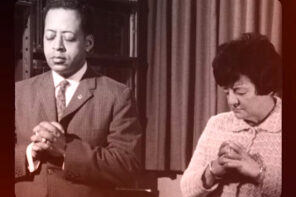Kurt Andersen in the Atlantic has given us a superb think-piece on how we arrived at our post-truth irrationalism, an American “Fantasyland” dominated by conspiracy theories, paranoia, outlandish ideas, fake news and alternative facts. The new information age accelerated the relativism birthed in the 1960s, Andersen contends, and now we can all mentally furnish our own fantastic dwellings with facts and ideas we want to be true—and we can even find countless likeminded individuals on the Internet who will confirm and embellish our deepest alternate realities.
It’s a great cultural history and a nuanced, detailed explanation of how we landed in our current predicament, culminating in a Donald Trump presidency. It’s also a deeply flawed account.
Before I explain how, take a few minutes—okay, half an hour—to appreciate the true weirdness of the story Andersen is trying to tell us. For Andersen, American exceptionalism consists primarily of the nation’s invention of the “fantasy-industrial complex,” of which it remains the powerful epicenter. A history of “epic individualism and extreme religion” was incubated by two powerful factors in the 1960s, then augmented, circulated, amplified by technological change wrought by the Internet.
For Andersen, the two movements inaugurated in the 1960s that would become the primary sources of American unreality were hippie New Age hostility to science and reason, and the new academic fashion of postmodern relativism. The former was tolerant of all kinds of outlandish ideas, often non-Western imported religious fragments, and challenged the presumptions of conventional psychiatry and medicine; this emergent counterculture was a “new generation of longhaired hyperindividualists who insist on trusting their gut and finding their own truth.”
The second 1960s movement is what would come to be known as postmodern relativism, ideas of which
filtered out into the world at large: All approximations of truth, science as much as any fable or religion, are mere stories devised to serve people’s needs or interests. Reality itself is a purely social construction, a tableau of useful or wishful myths that members of a society or tribe have been persuaded to believe. The borders between fiction and nonfiction are permeable, maybe nonexistent. The delusions of the insane, superstitions, and magical thinking? Any of those may be as legitimate as the supposed truths contrived by Western reason and science. The takeaway: Believe whatever you want, because pretty much everything is equally true and false.
Foucault, Feyerabend, Baudrillard—these postmodernists infected the academy with traditions of irrationalism that spread to the culture at large. Science, reason, and knowledge were social constructs. Though conservatives decried this academic relativism, “when it flowed out across America it helped enable extreme Christianities and lunacies on the right – gun rights hysteria, black helicopter conspiracism, climate-change denial, and more.”
There’s a lot here to chew on, and I’m certainly sympathetic to the argument that there are unanticipated sympathies between postmodernism and some conservative ideas, as I will explain shortly. But the real problem with this account is that it overemphasizes academic postmodernism and hippie New Ageism as origins of America’s post-truth fake news world, and makes the mistake—in my view—of downplaying religion.
What, after all, are the lines of influence from academic postmodernism and hippie New Ageism to what David Brooks called the “alternative-reality right”? In Andersen’s account, these ideas sort of enter the American milieu, where they cook in the stew of American individualism until they become adopted by conservatives in the 1990s. But this is a weak account of intellectual influence.
As far as we know, conservative thought leaders never seriously engaged with the likes of the postmodernists Andersen cites, such as Foucault, Baudrillard, or Feyerabend, except to condemn.
To give Andersen credit, he recognizes the asymmetry of our post-truth world, and locates its probable cause in religion. He writes,
But fantastical politics have become highly asymmetrical. Starting in the 1990s, America’s unhinged right became much larger and more influential than its unhinged left. There is no real left-wing equivalent of Sean Hannity, let alone Alex Jones. Moreover, the far right now has unprecedented political power; it controls much of the U.S. government. Why did the grown-ups and designated drivers on the political left manage to remain basically in charge of their followers, while the reality-based right lost out to fantasy-prone true believers? One reason, I think, is religion. The GOP is now quite explicitly Christian.
The problem with this account is that Andersen doesn’t follow this conservative religious influence backwards historically as a likely origin of asymmetric fantasy, stressing instead the undemonstrated influences of academic postmodernism and hippie New Ageism.
But the fact of the matter is that this very conservative religious tradition that remade the Republican Party in the 1980s and 1990s had already learned to discount expert knowledge and mainstream institutions like journalism and universities. As I argued earlier in “The Religious Origins of Fake News” here in Religion Dispatches, fundamentalist Christians long constituted their identity through a demurral on two intrinsically modern bodies of knowledge – evolution and the historical-critical Bible scholarship.
And they didn’t just reject the modern consensuses on evolutionary biology and the complex authorship, editing, and redaction of the Bible – they produced counter-institutions in the form of Christian colleges, newspapers, publishers, radio and then television shows, that cultivated counter-experts who confirmed divine creation and Biblical inerrancy and literalism.
Conservative white Christians, in other words, had had one foot in a parallel information ecosystem for a long time. This ecosystem held fast until the 1960s because the nation generally accommodated their beliefs. That changed in the 1960s when Supreme Court decisions struck down the legally-sanctioned practices of public school prayer, school Bible reading, and prohibitions against teaching evolution in many Southern states. Many white evangelicals had already been rattled in the previous decade when Christian segregationism was demolished by Brown v. Board of Education in 1954, inaugurating the Civil Rights movement. When conservative white evangelicals began to mobilize politically in the 1970s, it was in reaction to these things, as well as to changing sexual mores.
What this means is that the origin of asymmetrical truthiness that Andersen identifies in religion is actually a better explanation for that asymmetry than the primary influences he identifies in academic postmodernism and hippie New Ageism. The Christian Right as it developed in the 1980s to my knowledge never cited postmodern relativism or New Age ideas to defend its alternate reality. Indeed, it often inveighed against them.
Andersen doesn’t, in other words, follow the chain of influence back to the alternate information ecosystem that conservative white evangelicals were already inhabiting, and explicitly invoking as the decades went on.
1968’s Supreme Court decision undercutting prohibitions against teaching evolution prompted the organized response of legislating an “equal time” approach, wherein both evolution and creation science would be taught side by side. When a later 1987 decision decreed that creation science was religion and had no place in high school biology classrooms at all, creationists began to develop alternate language for reinserting God into human origins and speciation. That led, eventually, to the Intelligent Design movement and its ostensible agnosticism about the character of the Designer who was invoked as a necessary supplement to evolutionary processes. Still, conservative Christian politicians like Reagan and George W. Bush continued to call for teaching the controversial approach.
My point in rehearsing this history is that conservative religious traditions of combatting expert, mainstream knowledge by developing counter-experts and counter-institutions and alternate information ecosystems predates substantially the 1960s origin Andersen construes. Conservative Christians had long rejected aspects of expert knowledge, official science, reason, and their organs of circulation. They had been trained, as it were, not in the postmodernist hermeneutics of suspicion, but in the fundamentalist hermeneutics of suspicion.
Conservatives were not reading Foucault, Feyerabend or Baudrillard, or invoking vague New Age ideas about tolerance. Even the brainy Francis Schaeffer, as intellectual a theorizer of the Christian Right as it had, wasn’t reading or citing them. Schaeffer never invokes postmodern relativists in his intellectual account of the “rise and decline of western thought and culture.” And though he ministered to restless, seeking youth at his Swiss mission, he never imbibed their squishy spiritual opinions; he agreed with their diagnosis of modernity’s spiritual rootlessness, but believed they needed salvation in Jesus Christ alone. Besides his rejection of evolution and the historical-critical method, the outlandish ideas he sometimes articulated—that abortion would lead to widespread euthanasia, infanticide, and an authoritarian government by elites—were indigenous to his religious tradition, not borrowed from postmodernism or New Age hippies.
Schaeffer’s ideas were shared by fundamentalists Jerry Falwell and Tim LaHaye, who formed the Moral Majority in 1979 to influence American politics. Indeed, near the end of Francis Schaeffer’s life, according to his son Frank Schaeffer, he came to regret the alliance of the Religious Right he had been instrumental in developing, “saying privately that the evangelical world was more or less being led by lunatics, psychopaths, and extremists, and agreeing with me that if ‘our side’ ever won, America would be in deep trouble.” And here we are.
I agree that there appears in retrospect a strange sympathy (though not influence) between academic postmodernism and this Christian Right ecosystem of alternate knowledge. For instance, the purpose of creation scientists—and their updated incarnations as the Intelligent Design movement —in debating biologists is never actually to convince the scientists that the earth is only 6,000 years old, or that the Grand Canyon was caused by Noah’s flood, or that the complexities of biological systems is the handiwork of God. It is rather to produce the public appearance of undecidability: that the experts can’t really agree on the science. Under those circumstances, everyone must make a faith decision about what to believe of our biological origins—choose what you like.
This structure of debate is a fairly close approximation of Jean-François Lyotard’s famous account of science in The Postmodern Condition. Lyotard argues that science consists of a series of rhetorical utterances—that is, research publications—by scientists, for other scientists, with the goal of producing “new” work and being recognized by peers. This theory unmoors the practice of science from being about trying to give an accurate picture of reality, and makes it into a series of social acts, what he called “language games.”
The goal of creation scientists and intelligent designers can be imagined similarly: to provoke a mainstream scientist to answer a creationist utterance, thereby making it look like a scientific disagreement. They cheered when President George W Bush suggested that teachers should teach the “debate” between evolution and Intelligent Design in high school biology classrooms. It looks like science can’t decide, that evolution is just one “theory” amid a set of legitimately rival theories.
The point, for Intelligent Design and creation science, is not to get to the bottom of things with actual science, but to cloud the science, making it appear as though no consensus exists, and we all just have to make a faith decision about what to believe. In my book I call this Christian Postmodernism. It’s a term that denotes structural sympathy, not genealogical influence.
It’s remarkable that Andersen passes over the more demonstrable genealogy of our post-truth world in the influence of the Christian Right. This is the force that has taken over the Republican Party, especially in the primaries. It is an epicenter of many of the truthiness trends Andersen names, such as creationism, doubting anthropogenic climate change, birtherism, and others, like the efficacy of abstinence-only sex education. In Donald Trump, the Christian Right found its avatar of truthiness: 81% of white evangelicals voted for Trump, a higher proportion that Romney, McCain, or even the born-again George W. Bush. The most regular churchgoers continue to be most supportive of his presidency.
It bears repeating that not all Christians can be slotted into this post-truth category. A majority of black Christians and Hispanic Catholics, and significant minorities of mainstream Protestants and white Catholics did not rally around Trump’s candidacy. This merely underlines the fact that it is the particular faith heritage of white evangelicals, not all Christians, that played a more significant role in the development of our fake news, post-truth world than postmodern academic relativism or hippie New Ageism.
To be sure, the left is not immune to conspiracy, paranoia, truthiness and fake news, as Andersen rightly notes. Although early attempts at writing fake news for the left reported not being able to catch on, characters like Louise Mensch and others continue to provide fodder on social media platforms for liberals and progressives wishing a speedy end to our national nightmare, and willing to believe any counterfactual craziness to that end.
As Russian dissident, exile, and chess champion Garry Kasparov explained of the fake news circulating in our post-truth world, “The point of modern propaganda isn’t only to misinform or push an agenda. It is to exhaust your critical thinking, to annihilate truth.”
How to annihilate truthiness, on the other hand, seems like a much more difficult task.





